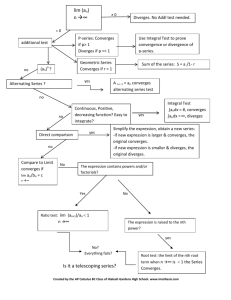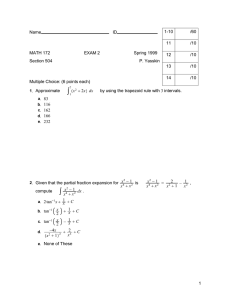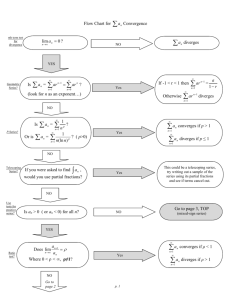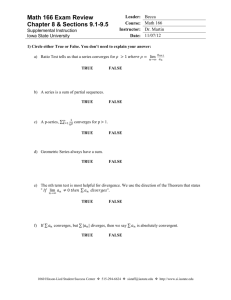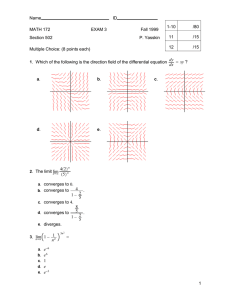MATH 152, SPRING 2010 FINAL EXAM - VERSION C √
advertisement
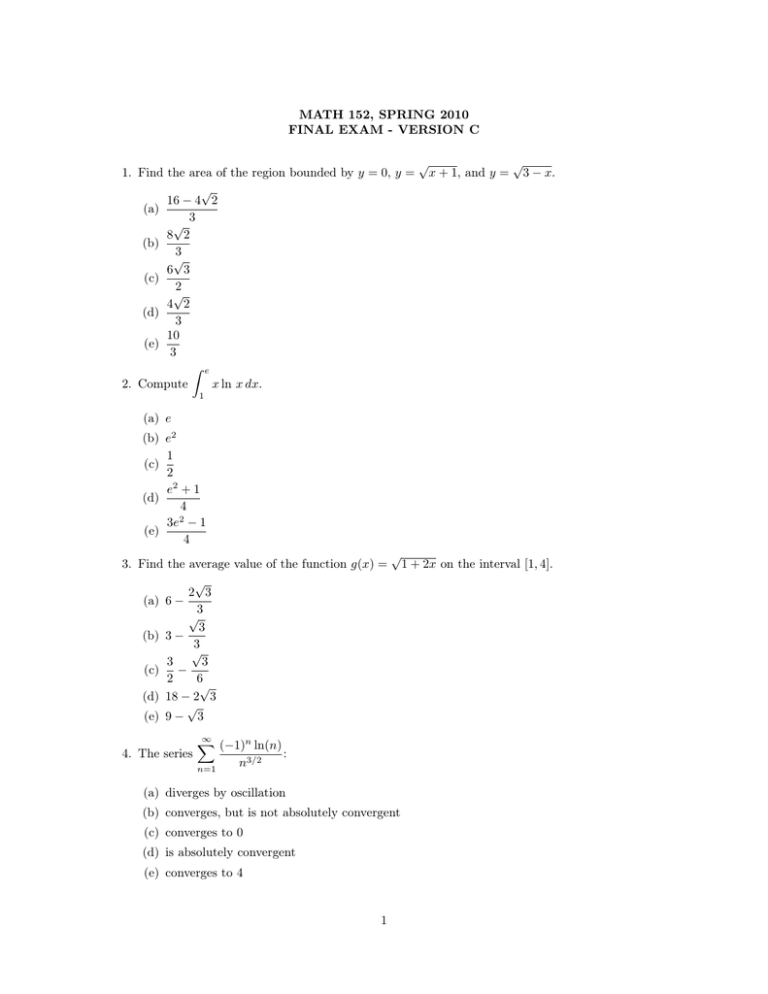
MATH 152, SPRING 2010 FINAL EXAM - VERSION C 1. Find the area of the region bounded by y = 0, y = √ 16 − 4 2 (a) 3 √ 8 2 (b) 3 √ 6 3 (c) 2 √ 4 2 (d) 3 10 (e) 3 ˆ e 2. Compute x ln x dx. √ x + 1, and y = √ 3 − x. 1 (a) e (b) e2 1 (c) 2 e2 + 1 (d) 4 3e2 − 1 (e) 4 3. Find the average value of the function g(x) = √ 2 3 (a) 6 − 3 √ 3 (b) 3 − 3 √ 3 3 (c) − 2 6 √ (d) 18 − 2 3 √ (e) 9 − 3 √ ∞ X (−1)n ln(n) 4. The series : n3/2 n=1 (a) diverges by oscillation (b) converges, but is not absolutely convergent (c) converges to 0 (d) is absolutely convergent (e) converges to 4 1 1 + 2x on the interval [1, 4]. ˆ 5. With an appropriate substitution, x2 p x2 − 4 dx is equivalent to which of the following? ˆ (a) 8 sin2 θ cos θ dθ ˆ (b) 16 sec2 θ tan3 θ dθ ´ (c) 16 sec3 θ tan2 θ dθ ˆ (d) 8 sec2 θ tan θ dθ ´ (e) 16 sin2 θ cos2 θ dθ 6. Which statement is true about the sequence an = (−1)n n+1 ? n (a) an diverges by the Test for Divergence (b) an converges to 1 (c) an converges to −1 (d) an diverges by the Alternating Series Test (e) an diverges by oscillation 7. The series ∞ X 2 : n(n + 2) n=3 (a) converges to 0 (b) diverges by comparison with ∞ X 1 n n=3 7 12 3 (d) converges to ln 5 3 (e) converges to 2 (c) converges to ˆ 8. Which of the following is the Maclaurin Series for ∞ X (a) (−1)n x4n+3 (4n + 3)(2n + 1)! n=0 (b) ∞ X (−1)n (x2 )2n+2 (2n + 2)! n=0 ∞ X (−1)n+1 x2n+4 (c) (2n + 4)(2n + 1)! n=0 ∞ X (d) (−1)n x2n+4 (2n + 4)(2n + 1)! n=0 (e) ∞ 1 X (−1)n+1 x4n+2 2 n=0 (4n + 3)(2n + 1)! 2 sin(x2 ) dx ? 9. Which integral gives the length of the curve y = x2 − ˆ 2 2x − (a) 1 ˆ 2 1 8x r 4x2 − (b) 1 ˆ 2 r x4 − (c) 1 ˆ 2 1 ln x from x = 1 to x = 2? 8 dx 1 + 1 dx 64x2 x2 ln x (ln x)2 + + 1 dx 4 64 r x6 x2 1 + 1 dx − + 9 12 64x2 1 ˆ 2 1 (e) 2x + dx 8x 1 (d) 10. Which is the graph of the polar equation r = 8 + 8 sin θ ? 3 h πi 11. The graphs of y = 2 sin x and y = sec x are shown below on the interval 0, : 2 (a) Find the volume obtained by rotating Region I about the y-axis. (b) Find the volume obtained by rotating Region II about the x-axis. 12. The curve parametrized by x = 3t − t3 , y = 3t2 , t ∈ [0, 1] is rotated about the x-axis. Find the area of the surface formed. 13. Given the power series ∞ X (x − 1)2n √ : n + 1 (9n ) n=0 (a) Find the radius of convergence. (b) Find the interval of convergence. 14. . (a) Find the third-degree Taylor Polynomial of f (x) = ln x centered at x = 2. (b) Estimate the error in your approximation on the interval [1.5, 2.5]. (Taylor’s Inequality may M |x − a|N +1 where M ≥ |f (N +1) (x)| ) be helpful here: |Rn (x)| ≤ (N + 1)! 15. The points (−1, 3, 2) (0, −1, 0), and (−2, 4, 3) lie in a plane. (a) Find a UNIT vector n which is orthogonal to this plane. (b) Show that the vector n is orthogonal to one of the vectors which lie in the plane. 4

